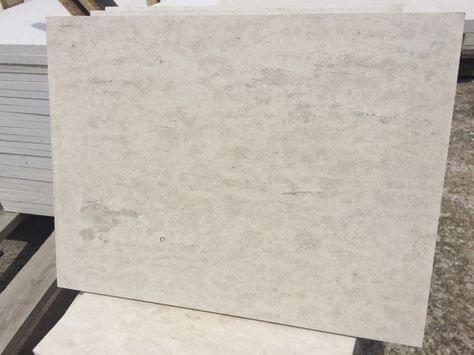Limestone is a hard sedimentary rock (formed by the deposit of minerals on the earth's crust within water) and is made up of minerals, calcite and aragonite - different crystal forms of calcium carbonate. Generally limestone is made up of the broken up remains of shells from animals that inhabited the water, as well as other living organisms like coral. These fragments have been deposited on water beds over millions of years to form a hard compressed rock. By volume, limestone accounts for about 10% of all sedimentary rock.
Where does Limestone come from?
There are countless limestones in existence around the world, even in Britain where it is generally found in the Peak District and the Cotswolds. It was the Romans who first discovered that you could polish British limestone into what they called Marmoro, which gave rise to the Italian word Marmo for marble. British limestones can be found in a range of colours including blacks, pure whites, greys, purples and greens. Unfortunately, as with most British stones, production methods and costs make British limestone tiles prohibitively expense, which is why most limestone tiles available in the market are imported from places like Bulgaria and Turkey.
Nowadays, most natural stone tiles including limestone are processed and manufactured in Bulgaria and Turkey.
It then comes down to money and whoever is willing to risk exposing or "opening" the quarry face to see what can be extracted in large block form, then cut into slabs and tiles. It doesn't always go to plan, and there have been many instances where quarries have been opened only to find that the material isn't good enough to be processed into tiles. Usually there will be an engineer involved who can determine the potential quality of a block of stone from the outside without having to cut it, but it doesn't always work out.
Limestone colours and durability:
Unlike marble - which typically has veins and faults known as "vents" which makes it quite fragile - limestone is much more stable and generally doesn't suffer from the fragility these kind of faults cause. This is mainly down to how it was formed in the first instance. However, it is generally softer and less durable than marble overall.
As a rule, the lighter the limestone colour is, the softer it will be and its potential uses are limited. Our Vratsa beige limestone has been around under different names for many years; it is generally known as Vratsa beige limestone after the region in Bulgaria where it is quarried. This lovely limestone is great in contemporary bathrooms, but it is also recommended for use where it will come into contact with heavy foot traffic - it doesn't tend to look worn and dirty in quite a long period of time.
Limestone Tile Quality:
Unlike travertine tiles that are categorized into numerous different grades, marble and limestone tiles are only available in two "selections". These are:
"A" quality – Generally known as premium grade in the market. These tiles are selected on the production line to conform to a particular factory's premium grade colour and pattern definition. If for instance elements like blacks or greens appear in a tile and these are not in the premium grade definition, they are selected out and sold as:
Tigar type – Anything that doesn't fit within the factory's 1st quality selection is sold as commercial grade. Commercial grade doesn't mean inferior integrity of the tiles; it just means that there will be colours and patterns within the tiles that aren't within their 1st quality selection. Typically, the overall appearance isn't as good as the 1st quality selection.
1st quality (or 1st choice as its often called) generally doesn't form the majority of a factory's overall production, making it significantly more expensive for retailers to buy in the first instance. Unfortunately, there are numerous retailers only too willing to offer commercial grade products as premium grade, so our advice is to be careful when choosing any natural stone product.
Limestone Tile Finishes:
Limestone tiles are cut and processed into a number of different finishes.
Honed – a dead flat matte surface with sharp edges.
Tumbled – an aged, worn/weathered and bleached out look with rounded off edges.
Polished – a shiny reflective surface with a sharp edge.
Brushed – a smooth textured surface with a rounded off edge – brushed retains more of the tile's original colour than tumbled.
In the market, honed limestone tiles are the most popular, then tumbled, polished and brushed. There are a few other surface finishes available like "pillowed" but these are really niche Limestoneproducts and the processing of this finish in the factory is time consuming and expensive, which has a knock-on effect on cost when it reaches the shops.Many limestone tiles are available in a polished surface finish but the level of the polishing is dependent upon the density of the stone. Soft limestones don't take to polishing as well as really hard stones, and the polished surface of a soft limestone will wear away over a short period of time if there is foot traffic on it. This is why we don't recommend the use of our Mediterranean white limestone polished tiles on living area floors unless you are prepared to have it polished up every so often.
Tumbled limestone tiles are best suited to older properties, although the use of tumbled tiles juxtaposed against modern furniture can look glorious if done properly.







Comments
Post a Comment